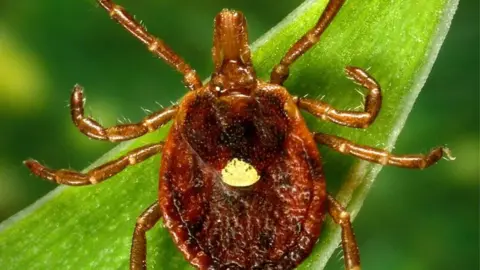Alpha-gal syndrome: Meat allergy linked to tick bites rising, CDC says
 Getty Images
Getty ImagesThe rate of Americans developing a rare meat allergy from tick bites is rising, researchers say, and may have already impacted as many as 450,000 people.
New data released by the Centers for Disease Control and Prevention (CDC) on Thursday shows a steep increase in cases of alpha-gal syndrome.
The allergy triggers a possibly life-threatening reaction to several types of meat or animal products.
US scientists have traced alpha-gal to saliva from the lone star tick.
The tick is identified by the white spot on its back and is mostly found in southern and eastern parts of the US. But experts warn that their range is expanding due to climate change.
Blood-sucking bites from the lone star, formally called the Amblyomma americanum, can make a person sick when they consume certain meat and animal products made from mammals.
The list of dangerous foods for people suffering from alpha-gal syndrome include pork, beef, rabbit, lamb, venison, gelatine, milk, some dairy products and certain pharmaceuticals.
Symptoms from the little-understood syndrome include stomach cramps, diarrhoea, hives and shortness of breath that could trigger fatal anaphylaxis.
Alpha-gel syndrome reactions can be different from person-to-person, ranging from mild to severe or even life-threatening, the CDC says. Anaphylaxis, a potentially life-threatening reaction involving multiple organ systems, may need urgent medical care.
But people may not have an allergic reaction after every alpha-gal exposure, the CDC notes.
Because of how slowly the body digests meat, it can be very difficult to spot any symptoms that do appear.
More than 110,000 cases have been detected since 2010, the CDC says. From 2017 to 2021 the number of cases increased by around 15,000 per year.
Due to difficulties with diagnosis, the CDC says that up to 450,000 Americans in total may have developed meat allergies due to alpha-gal.
A survey of 1,500 doctors and health workers from last year found that 42% of them had never heard of the syndrome.
In the survey, which was also released by the CDC on Thursday, about one-third of the group said they were "not too confident" in their ability to identify the disease. Only 5% said they were "very confident" in their ability.
The syndrome was not discovered until 2008 by accident after US researchers found unexpected results while testing a drug used to treat cancer.
The Ixodes holocyclus - aka the paralysis tick - has also caused similar meat allergies in the Sydney region of Australia.
Experts warn people to cover up outdoors and to regularly check their bodies for tick bites. Tick bites can cause several dangerous illnesses - such as Lyme disease - and are most common during warmer months.
The CDC advises people outdoors to use insect repellent, such as those containing DEET, or to pre-treat clothing with a chemical called permethrin.
 Getty Images
Getty Images